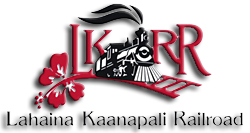The Sugar Cane Train: The Lahaina, Kaanapali & Pacific Railroad
Last revised: September 7, 2024
By: Adam Burns
The Lahaina, Kaanapali & Pacific Railroad, better known as the Sugar Cane Train, spent many years keeping alive Hawaii's rich railroading history.
In the process it entertained tens of thousands of tourists with short train rides typically pulled by authentic steam locomotives.
The little tourist line was located on the Island of Maui and had been in operation since 1969 when the Sugar Cane Train was started that year by A.W. "Mac" McKelvy.
Operations ceased on August 1, 2014 after the railroad claimed it was forced to close as a result of financial difficulties.
Unfortunately, despite claims the line would reopen in 2019 this has not occurred and both locomotives are currently for sale. The property has been eyed as valuable real estate for years and will likely be redeveloped at some future point.
The Lahaina, Kaanapali & Pacific Railroad (as it is officially known) operated about 6 miles of narrow-gauge railroad which connected Lahaina to Puukolii.
While the LK&P was certainly no Strasburg or Napa Valley Wine Train it nevertheless offered a unique and interesting operation in a tropical setting that, interestingly enough, was once teaming with railroads.
Historically, the Sugar Cane Train was another of the many plantation railroads found on the islands serving the Pioneer Mill located in Lahaina.
These small operations thrived through the first half of the 20th century throughout the island of Hawaii. There were also major, common-carrier lines located here including the Oahu Railway & Land Company and Hawaii Consolidated Railway.
With rail service becoming more expensive and not as flexible as trucks, the mill switched its mode of transportation to the latter.
In its 44 years of operation the Sugar Cane Train became a popular tourist destination and even spurred the upstart of other tourist lines on the islands which helped to tell the state’s railroading history (they include the Hawaiian Railway, Kauai Plantation Railway, and the Pineapple Express).
By large the general public is not aware that Hawaii featured quite a bustling railroad network across most of its islands.
Its earliest history with trains predate the islands' statehood when a small narrow-gauge line opened a few miles of track in 1881 at the Kilauea Plantation (on the Island of Kauai) to serve its sugar cane crop.
Most railroads located on the islands were used in just this capacity, small narrow-gauge operations designed to work the sugar cane fields, one of the state's important cash crops.
However, the large island of Hawaii did operate a very impressive standard-gauge line at one time, the Hawaii Consolidated Railway.
Chartered in the early spring of 1899 as the Hilo Railroad, it was renamed the HCR in 1914. By the time World War II hit the island on December 7, 1941 the railroad featured an impressive system that included a signaled, double-tracked main line, and several extensions serving various businesses around the island.
Unfortunately, the tsunami that hit on April 1st, 1946 devastated the railroad permanently closing the operation.
The Sugar Cane Train operated a year-round schedule due to the balmy, tropical climate in which it is located.
They usually ran trains four times a day from three different locations; Puukolii, Kaanapali, and Lahaina with reasonable ticket prices.
Prior to the railroad's shutdown there were plans to further expand services to host special events and trains but alas, these were never realized.
Locomotive Roster
The railroad's motive power fleet consisted of three steam locomotives, and one diesel locomotive; all but one was operational during the railroad's peak years.
- #1, "Anaka": An 0-4-0 design built by the H.K. Porter, Inc. for the Carbon Limestone Company. It is currently in operating condition.
- #3, "Myrtle": A 2-4-0 design built by the H.K. Porter, Inc. for the Carbon Limestone Company. It is currently in operating condition and the most often used locomotive to pull excursions. The engine is beautifully restored and sports a vibrant paint scheme
- #5: An 0-6-2 design used by the Oahu Railway & Land Company. It is currently awaiting restoration
- #45 Oahu: A small diesel switcher built by the Plymouth Locomotive Works. It is operational and helps with moving cars and other equipment around the property.
While I know most folks go to Hawaii for the beaches and the sun, if you have a chance you may also want to either visit one of the state’s few remaining tourist railroads or the Hawaiian Railway Society to get a glimpse at what railroading was once like in the Aloha State.
For more information about the Sugar Cane Train please click here to visit their website.
There you can learn much more about all of the services they currently offer visitors including pricing and area attractions. To learn more about the history of Hawaii's railroads please click here.
Recent Articles
-
Rio Grande 2-8-2 Locomotives (K-37): Specs, Roster, Photos
Apr 15, 25 12:57 PM
Rio Grande's Class K-37 Mikes were itsdge steamers to enter service in the late 1920s. Today, all but two survive. -
Rio Grande 2-8-2 Locomotives (K-36): Specs, Roster, Photos
Apr 15, 25 11:09 AM
The Rio Grande's K-36 2-8-2s were its last new Mikados purchased for narrow-gauge use. Today, all but one survives. -
Rio Grande 2-8-2 Locomotives (Class K-28): Specs, Roster, Photos
Apr 14, 25 10:24 PM
Rio Grande's Class K-28 Mikados were its newest narrow-gauge steam locomotives since the Mudhens of the early 1900s. Today, three survive.



